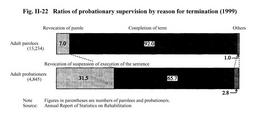| Previous Next Index Image Index Year Selection | |
|
|
4 Results of implementation of probation (1)State on termination of probation
Fig. II-22 shows component ratios of probationers and parolees whose probationary supervision terminated in 1999, by type of probationary supervision and reason for termination. The reason for termination was most often completion of the probationary supervision term, accounting for 12,178 adult parolees and 3,182 adult probationers(of whom 531 were under provisional suspension of probation). Viewing the ratio of probationers and parolees whose probationary supervision was terminated due to revocation of parole and revocation of suspension of sentence in 1999, by type of offense at the time of start of probationary supervision(excluding offenses for which less than 100 probationers had their probation terminated), the former was highest for larceny (11.9%), followed by Poisonous and Deleterious Substances Control Law violations (9.3%) and fraud (7.6%), in that order. The latter was highest for larceny (40.2%), followed by Stimulant Drug Control Law violations (34.0%) and fraud (31.1%) (source:Annual Report of Statistics on Rehabilitation). Fig. II-22 Ratios of probationary supervision by reason for termination (1999) (2)Data on repeat offenses and re-admission Fig. II-23 shows the ratio of probationers and parolees whose probationary supervision terminated after 1990 and who were newly sentenced for a repeat offense committed during their probationary supervision(referred to below as the "repeat offense rate"). The repeat offense rate is on a par at around 1% for adult parolees and between around 30% and 40% for adult probationers. The repeat offense rate in 1999 was 1.1% (147 offenders) for adult parolees and 34.4% (1,667 offenders) for adult probationers. Moreover, viewing the repeat offense rate in terms of the original offense(excluding offenses for which less than 100 probationers had their probation terminated), the highest among parolees was homicide (3.1%), followed by robbery (3.0%), rape (2.5%), and indecent assault (1.7%), in that order. Among adult probationers, the highest was larceny (41.5%), followed by Stimulant Drug Control Law violations (37.4%), bodily injury (35.6%), and fraud (35.6%). Meanwhile, road traffic violations and bodily injury accounted for more than 40% of repeat offenses committed by adult parolees whose original offense was homicide or robbery, but no parolees repeated the same type of offense (source:Annual Report of Statistics on Rehabilitation). Fig. II-23 Trends in repeat offenses during probation (1990-1999) Fig. II-24 shows the ratio of parolees released from correctional institutions and inmates released on completion of their sentence since 1988 who were re-admitted to a correctional institution within 3 years of their release(the recidivist re-admission rate). The recidivist re-admission rate consistently tends to be lower for parolees than for inmates released on completion of their sentence. Of those released in 1997, the rate was 25.7% for the former but 43.9% for the latter.Fig. II-24 Trends in recidivist re-admission rates, by reason for release (1988-1997) |


